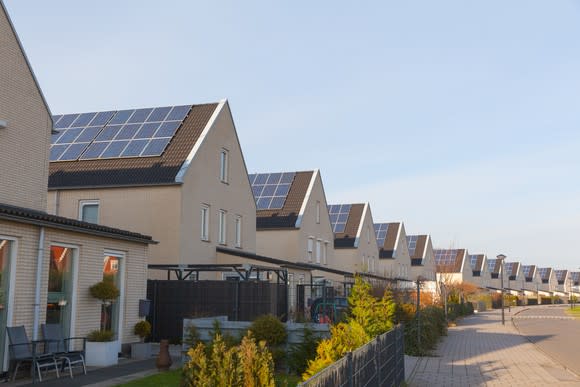What to Expect From Vivint Solar in 2018
It's been an up-and-down year for the residential solar industry -- and for Vivint Solar (NYSE: VSLR, in particular. The company lost market share to Sunrun (NASDAQ: RUN) but also watched Tesla (NASDAQ: TSLA) shrink its own residential solar business. It's as if the company was running in place in 2017.
Then there's the uncertainty brought on by potential solar tariffs, which will be determined next week. Amid the ups and downs, here's what to watch with Vivint Solar in 2018.

Image source: Getty Images.
Tariffs could be a challenge
If the Trump administration decides to put tariffs on solar imports, it'll raise costs for Vivint Solar, which will either reduce its potential market or squeeze margins. But until we know what tariffs will look like, it's hard to say whether the cost will be $0.05 per watt, a marginal increase, or a more meaningful $0.30 per watt, or 10% of a system's cost if the price of solar panels nearly doubled (current panel prices are around $0.35 per watt).
The best-case scenario would be no tariffs at all. That would allow Vivint Solar to lower costs elsewhere to expand margins or its market. A decision is due by Jan. 12, so it won't take long into the year to know whether solar tariffs are coming or not.
Cashing in on existing assets
Since its inception, Vivint Solar's business model has been to sign customers to long-term leases or power purchase agreements, creating a stream of cash flows that would last 20 years or more. To estimate value, the company uses a measure called retained value, which is the present value of those future cash flows.
At the end of the third quarter, management said that retained value was $1,176 million, or $1,535 million if you include the value of a lease renewal. By that measure, net retained value, which pulls out all debt and adds back cash on the balance sheet, was $723 million, or $6.30 per watt.
In other words, management said there's $259 million more in value on the balance sheet than the company's market cap. If they can sell some of those cash flows in securitization, it would unlock value and reduce Vivint's Solar's financing risk. Look for some kind of securitization to bring in cash, which could be a boost to Vivint Solar in 2018.
A changing business model
The other major change taking place in the last year is a shift away from leasing solar systems to more system sales. In the third quarter, 10.4 MW of Vivint's 46.5 MW installed were from system sales, which bring in immediate cash rather than needing to be financed over 20 years. I expect the shift to system sales to continue in 2018, although the company is a long way from generating most of its revenue from solar sales.
Another product to add to the mix is energy storage, which doesn't have a large market share in the U.S. but should grow rapidly in 2018 as utility rate structures make it more attractive to customers. Vivint has partnered with Mercedes Benz Energy Storage to bring storage to customers, and we should expect growth in storage sales and financing throughout the year.
What's clear is that at the end of 2018, Vivint Solar will be a very different company than it was a year ago, and solar sales and energy storage will play a big role in the shift.
A transitional year
The residential solar industry has been going through a number of transitions over the last few years. One is the shift to solar sales, as I've mentioned, which Vivint Solar is adjusting to well. Another is market share gains by regional installers, which works against Vivint's business model of the national installer. But the company hasn't shrunk, partly because Tesla has throttled back its own solar business.
Where I think Vivint Solar can maintain a strong position is the combination of solar financing and a complete solar and energy storage solution. Storage will need someone controlling it, and a company that has an incentive to increase value generation will align the installer and customer. Vivint Solar fits the bill, and that could allow it to distinguish itself from smaller installers that won't have their own energy control systems.
More From The Motley Fool
Travis Hoium has no position in any of the stocks mentioned. The Motley Fool owns shares of and recommends Tesla. The Motley Fool has a disclosure policy.

 Yahoo Finance
Yahoo Finance 